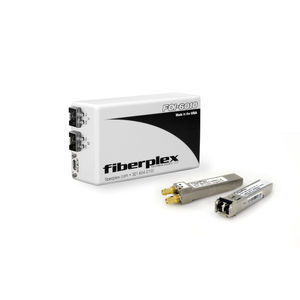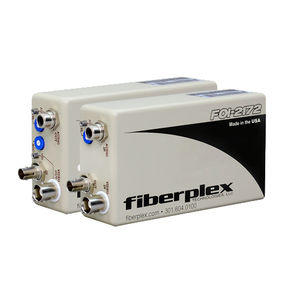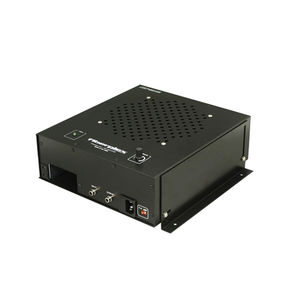
- Robotics - Automation - Industrial IT
- Automation
- Communications converter
- FiberPlex Technologies, LLC
- Products
- Catalogs
- News & Trends
- Exhibitions
Communications converter FOI-4451serialfiber opticRS422

Add to favorites
Compare this product
Characteristics
- Type
- communications
- Bus
- serial, fiber optic, RS422
Description
he FOI-4451 and FOI-4541 both provide complete electrical isolation for RS- 422 communications. The units are transparent to all handshaking protocols and can accept data and clock signals up to a maximum rate of 6.144 Mbps. A regeneration switch on the FOI-4451 allows users to toggle between synchronous applications that require Send Timing (ST) and asynchronous or synchronous applications that require Terminal Timing (TT). They support tail circuit and null modem functions for DCE to DCE or DTE to DTE communications. This requires two of the same FOI units. An alternate interface (V.35 or RS-232) may be installed at the opposite end, allowing the user to create a link between two electrically incompatible interfaces without requiring a separate interface converter.
The units can be used in areas of high electrical noise or in and out of RF shielded enclosures. The fiber optic cable is not susceptible to interference caused by impulse noise, crosstalk, or EMI. Privacy of communications is also enhanced because the fiber optic cable does not radiate any emissions. FiberPlex recommends “T” units for high security applications because they have been TEMPEST tested and approved. In addition, fiber optic cable offers much longer transmission distances than traditional RS-422 cabling. Multimode optics on the units can extend the distance to 2km, while singlemode optics can further extend the distance to 20km. A typical link consists of an FOI-4451 at the Data Communication Equipment (DCE) and an FOI-4541 at the Data Terminal Equipment (DTE) with a duplex fiber optic cable between them.
Catalogs
Fiberplex FOI Brochure
4 Pages
Related Searches
- Ethernet switch
- Digital master module
- Industrial network switch
- DIN rail ethernet switch
- Transceiver module
- SFP+ ethernet switch
- Ethernet transceiver module
- Serial converter
- SFP transceiver module
- Data transceiver module
- Fiber optic transceiver module
- High-speed transceiver module
- Multiplexer
- Single-mode transceiver module
- RS232 converter
- Optical fiber converter
- I/O card
- RF transceiver
- Power IC converter
- Slave master module
*Prices are pre-tax. They exclude delivery charges and customs duties and do not include additional charges for installation or activation options. Prices are indicative only and may vary by country, with changes to the cost of raw materials and exchange rates.









